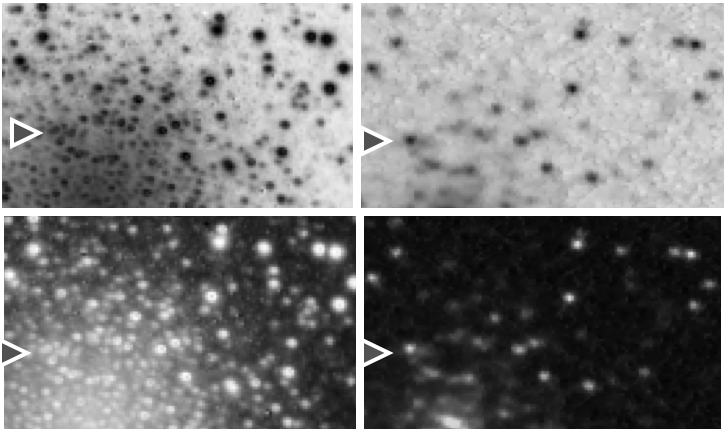M15, Pease 1 Nebula
M15, Globular Cluster
I wrote this blog on 28th November, 2010.
Last night i was imaging M15 with only 2 minutes of sub exposures and got 86 images in total. I was internally autoguiding at 11 Hz, which means that the image was being corrected 11 times a second (I so wish i could go beyond 30 or 40 Hz to kill the seeing.. I need a 30 inch scope for that). Clear filter and Hutech 2” LPS light pollution filter were used for the acquisition. The sky aound M15 was at 18 magnitudes per arcsec square, when i started the imaging and got 16.88 when i took the last image, which means the sky background was okay and . All went fine.. i did not loose the guide star, no cloud interrupted the imaging session. Only that my eternal enemy the smoke from the ‘Packages Factory’ was blurring the sky above me since i could smell the distinct ‘flavours’.
When autoguiding is performing flawlessly i am free to move out of the observatory and go downstairs.. talk to my kids.. watch youtube or just simply show the desktop of the observatory’s computer on my iphone to my family and torture them with the details of how great autoguiding is :) They try their best to make me happy.
Okay back to imaging: The calibration (cleaning of the images) is not perfect, because after the calibration i could still see unwanted pixels response. The only filter i used in MaXimDL was the digital development filter which is so very important for processing of the globulars. Then the combined image was brought in CS5 and i tried to compress the noise as much as i can.. some enhancements and the above image was ready to display.
There are only four Planetary Nebulae, found in the globular clusters. Pease-1 is one of them and is also the first PN found in a Globular cluster. I wanted to see if i have got it in my image. First step: whats the location of Pease1 in M15?
I found this website which helped me a lot in locating the exact position of the nebula. Pease1 is very tiny just a couple of arcseconds in size. This is very hard to image because the seeing should be good enough for the stars to stay where they are and last night’s seeing was not at all good. I could see the guidestar jumping all over in the autoguider window and AO8 was doing its best to tame it.. The best it could do was to get me at the minimum of 2.31 arcseconds per pixel, the worst frame was 3.06 arcseconds per pixel. I knew i wont be getting any structure of this nebula.
Okay so the above mentioned site has this picture:
This image was taken at the same camera angle that i was using.. following is my image:
Another good image is available here:
Now i could find the stars nearby and found the nebula in my image.
So there it is.. the first ever nebula discovered in a globular cluster. Okay.. it does not seem a nebula in my image but still it is a nebula.. you can check your references :) Colored image? perhaps i will attempt it but M15 is getting low in the west everyday and i dont think i will be able to get enough time for a colored image. Better yet i should attempt a 1 minutes exposure.. the sky background is already very bright here.. for these images the best value was 1219 ADU and the worst.. well 2873.. ouch.
And before i close this.. This is ‘Where is M15’.
One of the most significant tools astronomers, both professional and amateur, rely upon is the use of various band-pass filters. These belong to mainly two categories: Broadband filters and Narrowband filters; the control to pass or block certain wavelengths give enormous advantage to know what processes are happening so far away, in the heavenly bodies.
Every object emits maximum light at certain wavelengths. Planetary Nebulae emit most of their light from doubly ionized oxygen, better known as OIII (O3). Which can be recorded by the use of an OIII filter which will allow wavelengths from 494-506 nm to pass through and block all other light of M15 cluster. This should greatly dim the stars BUT should not dim the light of any planetary nebula.
Thinking on these lines, on the night of 28th November, i tried Astronomik OIII filter, which has a transmission of 95% from 496-501nm, on M15.
Since very little light would be coming in, i increased the sub-exposures to 15 minutes. I got 12 frames, 11 with 15 minutes and one with 10 minutes, making a total of 2 hours and 45 minutes of OIII emission from M15 cluster.
My current imaging setup gives me a very challenging f-ratio, F12. Two hours and 45 minutes are not enough with a use of 12nm filter. Though i tried my best with good calibration data and photoshop but still the combined image is noisy.
But i was not going for a neat and clean image.. I was after the planetary nebula.. Did i get it? Yes i did. See the following images:
Above images mark the exact location of the planetary nebula in M15 cluster. The left image shows all the stars with their usual brightness, but on the right the stars are all faded away but the spot where Planetary Nebula is located is seen very bright. Finally, this confirms that it is a planetary nebula.
Now i really want to get more than that but I am already at the image scale of 0.93 arcseconds, i know i will not be able to get any structure of this nebula.. since the seeing and transparency is not good from my city but for more we are blessed with Hubble.
-------------------------------------------------------------------------------------------------------------------------------------------------------------------------------------------------------








